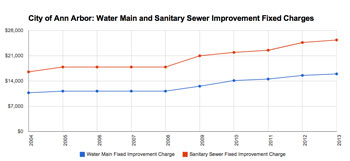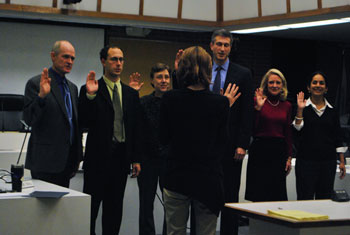Column: On Taking Time to Hear
At the Aug. 18 Ann Arbor city council meeting, anti-Israel activists left council chambers mid-session. Their parting shot was to contend that the council cared more about deer than about people. The reference to deer was an allusion to an agenda item that allocated $20,000 for development of a deer management plan. It was approved by the council in a unanimous vote.
But this column is not about deer versus people. It’s about corporations versus people. Also football. Even the U.S. Constitution.

This is the electronic time clock at the public speaking podium in Ann Arbor’s city council chambers. The elements in red (except for the American flag in the background) have been digitally added.
First, here’s some background. On Aug. 18, the anti-Israel activists had not been able to address the council during reserved public comment time at the start of the meeting – because the council rules stipulate that preference is given to speakers who want to address an agenda item. A boycott against Israel was not on the agenda.
So during that comment period, the council heard from five people who spoke in favor of spending the $20,000 on a deer management plan. The other five reserved slots were taken by: Thomas Partridge, who was officially signed up to talk about the planning commission’s work plan (one of the attachments in the clerk’s report); two people who signed up to talk about revisions to the taxicab ordinance; and two people who had signed up to talk about the lease agreement with the University of Michigan for three parking lots at Fuller Park.
That meant that anti-Israel activists were not able to reprise their demonstration at the previous council meeting, on Aug. 7, when eight of their group were signed up to speak. On that occasion, nearly all the commentary was complete. But then chants of “Boycott Israel” led mayor John Hieftje to recess the meeting. And he eventually decided to have Ann Arbor police clear the room of more than 50 activists. In this case, “clearing the room” translated into two officers telling the group’s leaders – Blaine Coleman and Mozghan Savabieasfahani – that they and their group had to leave. And after a few minutes, amid more loud chants and heated statements, the group left council chambers under their own power.
The contrast on obvious display at the Aug. 18 meeting was between two types of meeting attendees: (1) those who wanted to address the city council about an agenda item; and (2) those who wanted to address the council, but not on an agenda item.
That’s not the contrast I want to focus on. I want to focus on the contrast between two speakers who were alternates on the waiting list for reserved speaking time – both of whom wanted to address the council about an agenda item.
The two alternates were: Larry Baird, an Ann Arbor resident who signed up to talk about the Fuller Park lease agreement; and Michael White, a representative of Uber who was attending the meeting to speak against regulation of drivers for hire. Baird was slotted ahead of White on the alternate list. [Full Story]







